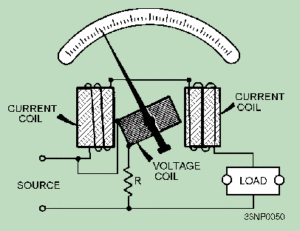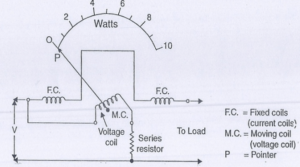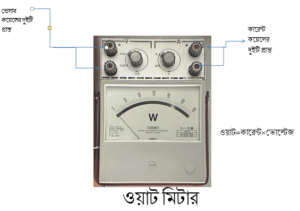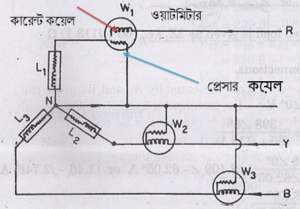Wattmeter is essential instruments used to measure the real power consumed by electrical devices. Before diving into the details of wattmeters, it’s crucial to understand the concept of watt, which refers to the unit of power indicating how much energy a device consumes over time. This article explores the construction and working principle of wattmeters, with a focus on AC wattmeters commonly used in industrial applications. Additionally, it provides insights into how wattmeters measure power and the role of current and potential coils in this process.
Before learning about the wattmeter, let’s explore some basic questions about watts.
Watt
Simply put, a watt is a unit of power. We know that any machine, whether electrical, electronic, or mechanical, requires energy to operate. Similarly, the amount of energy a device/load consumes in a specific time to complete a task is referred to as wattage.
A wattmeter is used to measure watts. It can also be calculated using Ohm’s law.
The formulas to calculate wattage are:
- P = V * I * Cosθ
- P = I2 * R * Cosθ
- P = (V2 * Cosθ)/R
P = Power, measured in watts
I = Current, measured in amperes
V = Voltage, measured in volts
R = Resistance, measured in ohms
Cosθ = Power factor, representing the phase angle value
Where is a Wattmeter Used?
A wattmeter is used to measure real power. In other words, the power we use in our daily lives is measured by a wattmeter. Simply put, a wattmeter is used to measure watts (the unit of real power).
We generally use two types of wattmeters:
1) DC Wattmeter
2) AC Wattmeter
Since AC wattmeters are mostly used in industries, an explanation of AC wattmeters is provided below.
AC Wattmeter
How is a Wattmeter Constructed? (Construction of Wattmeter)
Since a wattmeter is used to measure power (in simple terms, power is the product of voltage and current), it is clear that a wattmeter contains two coils:
1) Current Coil (C.C)
2) Potential/Voltage/Pressure Coil (P.C)
The current coil is connected in series with the load, and the potential coil is connected in parallel with the load.
(For better understanding, refer to the image below)

The current coil is divided into two parts and placed on either side, while the connection between them remains intact, with the potential coil placed in the middle.
Here, the current coils are stationary, while the potential coil rotates to provide the wattmeter reading. Hence, the indicator needle is connected to the potential coil.

Since the potential coil rotates, it must be lightweight, meaning the potential coil is wound with fine wire. Therefore, fine wire is used to wind the potential coil.
We know that if too much current flows through a fine wire, it can burn out. To prevent this, a large resistor is connected in series with the potential coil to limit the current flow and protect the coil from burning.
How Does a Wattmeter Work? (Working Principle of Wattmeter)
When a wattmeter is connected to a load, i.e., the current coil is connected in series and the potential coil in parallel, a large current flows through the current coil while a small current flows through the potential coil.
As current flows through the current coil, it creates a magnetic field around it, which acts on the potential coil. Thus, the magnetic field generated by the current coil helps rotate the potential coil.

When current flows through the potential coil, it begins to rotate due to the magnetic field generated by the current coil. Therefore, both the current and potential coils must have current flowing through them for the wattmeter’s needle to rotate. This is how a wattmeter measures power using both the current and potential coils.
If more current flows through both coils, a stronger magnetic flux will be generated around the current coil, causing the potential coil to experience more torque, resulting in a higher wattage reading.
Wattmeter

Connection Diagram of a Wattmeter in a Three-Phase Circuit:

1. What is the wattmeter method used for?
The wattmeter method is used to measure the electrical power consumed by a load. It calculates the real power in watts by measuring the product of voltage, current, and the power factor. This method is essential for monitoring and managing electrical energy consumption in various applications.
2. Can a wattmeter measure current?
A wattmeter itself does not measure current directly; it measures power. However, since power (in watts) is the product of current (in amperes) and voltage (in volts), a wattmeter can indirectly provide information about current when used in conjunction with voltage measurements.
3. Which effect is used in a wattmeter?
Wattmeters utilize the electromagnetic effect to measure power. Specifically, they rely on the interaction between the magnetic fields generated by the current and voltage coils. This interaction produces a mechanical force that is proportional to the power being measured, allowing the wattmeter to provide an accurate reading.
4. What is the principle of a wattmeter?
The principle of a wattmeter is based on the interaction of two coils: the current coil and the potential (voltage) coil. The current coil is connected in series with the load, while the potential coil is connected in parallel. The power measured is proportional to the product of the current flowing through the current coil and the voltage applied across the potential coil, adjusted for the power factor.
5. What is the use of one wattmeter?
One wattmeter is commonly used in single-phase circuits to measure the power consumption of electrical devices. It provides a direct reading of the real power being used, which is crucial for energy management and efficiency analysis.
6. Where to use a wattmeter?
Wattmeters are used in various settings, including industrial, commercial, and residential environments. They are essential in applications where accurate power measurement is required, such as in electrical testing, energy management, and performance monitoring of electrical systems.
7. How to measure with a wattmeter?
To measure power with a wattmeter, follow these steps:
Connect the Wattmeter: Connect the current coil in series with the load and the potential coil in parallel with the load.
Power On the Circuit: Ensure that the circuit is powered and operating under normal conditions.
Read the Measurement: Observe the reading on the wattmeter dial or display, which indicates the real power in watts being consumed by the load.
Adjust Settings if Necessary: For more accurate readings, ensure that the wattmeter is correctly calibrated and the power factor is taken into account.
8. Is a wattmeter used to measure AC or DC power?
A wattmeter can be used to measure both AC (Alternating Current) and DC (Direct Current) power, but the type of wattmeter used depends on the nature of the power being measured:
AC Wattmeter: This type of wattmeter is designed to measure the power in AC circuits. It accounts for the alternating nature of the current and voltage and calculates the real power by considering the phase angle between them. AC wattmeters are commonly used in industrial and residential applications where AC power is used.
DC Wattmeter: This wattmeter measures power in DC circuits. It is simpler than an AC wattmeter because DC power does not involve phase angles or alternating currents. DC wattmeters directly measure the product of voltage and current to determine the power.



